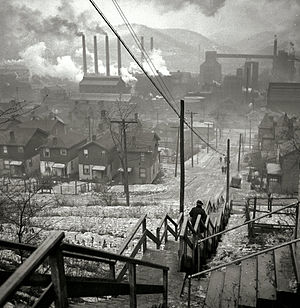
English: Steel mills and a long staircase in the South Side Slopes neighborhood of Pittsburgh, Pennsylvania, United States. (Photo credit: Wikipedia)
As we filled out tons of paperwork during the course of planning my mother’s funeral, I was a little bit surprised by my father’s insistence on filling out the documents by including what I thought was a long-ago discarded “Jr.” as part of his name. My father’s inclusion of the suffix reminds me that there are a few things to convey about my paternal grandfather as a participant of The Great Migration.
He was the first one to migrate northward in his family, taking with him my paternal grandmother, the first one to migrate from her family. He was lured by the promise of big money to be made in the steel mills. When they arrived in Pittsburgh in 1942, the onset of World War II meant that there was a great deal of money to be made in steel. The unions had gained a foothold in the first part of the twentieth century, but big business had made it a consistent desire to break those unions. The big bosses turned to the African Americans of the South to lure them to steel-producing cities like Pittsburgh, as strikebreakers.
Doubtless, he did not know he was taking someone’s job. All he knew was that he was getting paid more than he ever had, and worked hard to create a better life for his sons. Despite not being allowed to join the existing unions, African American steelworkers like my grandfather could see the horrible conditions in the mills and made inroads to the unions in different ways. According to Joe Trotter and Jared Day in their book Race and Renaissance, African American steelworkers created their own unions, but continuously sought to join predominately white unions on their own terms.
As the lowest in rank, African Americans had to work the hardest and most dangerous jobs in the mills. They were exposed to the most heat and noxious fumes. It was the fumes that got to my grandfather and weakened his lungs, rendering him an invalid for the last ten years of his life. I have the vaguest memories of a snappily-dressed, curmudgeonly man who sat in a corner in an overstuffed barcalounger. He would play with my sister and me by creating a monster’s lair behind the chair. He would come at us from opposite sides of the chair, and growl and threaten to get at us. We would squeal and shrink away from him in mock horror, never really wanting to escape his terrifying clutches.
I was too young to understand why he didn’t get up from the chair more often. Neal Huguley, Sr. was only 56 when he died, an age that seemed ancient to me when I was six, but now seems much too young an age to die. I now understand what that Jr. was for. My father, as well as my son, carry his name forward. We are all grateful beneficiaries of his great sacrifice for a better life.

wow Piper…your blogs are so interesting,,so easy to read ..yet so very informative…your mom continues to join us together through your beautiful writing…
Hey Patti,
I’m just trying to do as I know she would want me to do… Thank you so much for stopping by!